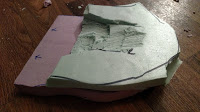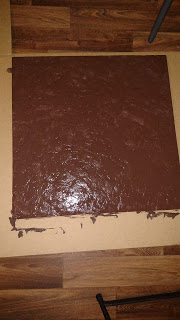

Over the past weekend, Nick and I attended the Siege of Augusta Wargaming convention in Augusta, GA to help out the Firelock Games crew. During the event Nick was testing out a new scenario that we will be using at our FLGS Giga-Bites Cafe on February 10th and I had the opportunity to run a multiplayer teaching scenario called Treasure Island using my new Caribbean Island board.
There has been quite a bit of demand for me to post the rules for others to use so here you go!
TREASURE ISLAND
Treasure Island is a fun, light-hearted scenario designed to teach up to six people the basics of Blood & Plunder in a single sitting. Each player will be given a 4-man unit of long guns and a 4-man unit of sailors. Here is what is recommended:
Spanish: 4 Corsairos, 4 Marineros
English: 4 Freebooters, 4 Sea Dogs
French: 4 Filibustiers, 4 Marins
For this scenario, there will be no commanders or Force specialty rules, just what is listed in the model entry.
Game Materials Needed
1: 4×4 Water/Ocean Mat.
2: Multiple island or hill terrain pieces that can act as islands that will fill up approximately 50% of the board.
3: Jungle/woods terrain and appropriate scatter terrain to help fill in the board.
4: One longboat with a Swivel Gun
5: Enough dice to pass around the table. 12 is enough to cover most players.
6: One single deck of cards.
7: 8 Milicianos Indios models for the hostile locals.
8: 8 Treasure Markers. These should be approximately 25mm to 30mm. A standard figure base will work for these.
Set Up
Place the longboat in the center of the board. Place the island pieces on the board, leaving approximately 6-8 inches of water between each island piece. Place the terrain on the island pieces as you see fit. Place the 8 Treasure Markers on the island pieces at least 8 inches away from a board edge and try to leave at least 6 inches between each Treasure Marker. Do your best to spread them out. Deal each player one card per unit (2 cards).
Deployment
Each player will spread out around the four sides of the table and deploy their units one card length in on the board (approximately 4 inches). Try to make sure that they are appropriately spaced out. Game play will then continue as normal.
Special Scenario Rules
Unknown Lagoon: Models will move through the water and treat it as difficult terrain. They will be able to make standard Shoot Saves. If a unit ever becomes Shaken while in the water, the unit drowns and is removed from the table. While in the water, units cannot fire muskets. Bows and Pistols can fire normally.
Digging Up The Treasure: any unit may spend one action while at least one model is in base contact with a Treasure Marker to dig it up and carry it. Any unit that carries the Treasure Marker will be moving at -1 inch per action point unless the unit with the Treasure Marker is in the longboat. The moment they dig it up, roll 1d10 and consult the chart below.
Roll: Result
1-3: Angry Locals: Place a 4 model unit of Milicianos Indios approximately 10 inches away from the unit that just dug up the Treasure Marker and make one Shooting Attack against that unit.
If there are 2 units of Milicianos Indios on the board then nothing happens.
5-8: Small Treasure Pile: Getting this Treasure Marker to the board edge will score 5 Points.
9-10: Large Treasure Pile: Getting this Treasure Marker to the board edge will score 10 Points.
Any unit may choose to drop a Treasure Marker at any time to move normally. If a unit is removed from the table while holding a Treasure Marker it will be placed in the center of where the unit was. If a Treasure Marker is dropped in the water then it will take 2 Actions to pick it up.
Angry Locals: Once the Milicianos Indios are deployed on the board they will receive one card per unit for initiative and activation. When they activate, they will focus on attacking the closest unit holding a Treasure Marker. If there are no units holding a Treasure Marker then they will attack the closest unit.
Reinforcements: When a unit is removed from the board it will re-deploy on any board edge of the player’s choosing at the beginning of the following round before initiative cards are handed out.
Scoring
Removing an enemy model from the board with a Fight or Shoot action: 1 point/model.
Getting a Small Treasure Pile to the board edge: 5 Points.
Getting a Large Treasure Pile to the board edge: 10 Points.
The player with the highest score at the end of the game wins.
Ending The Game
This will be up to the organizer but it is recommended that the game last 6 to 8 rounds in total.
And there you have it! One pirate-filled scenario ready to be run at any convention or game store!
Until next time,
-Tim




























